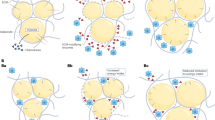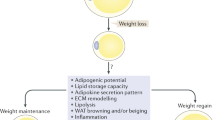Abstract
Purpose of Review
Weight loss has multiple beneficial effects on body composition and metabolism, but whether these depend on the rate at which body weight is lost is not clear. We analyzed data from studies in which the same amount of weight loss was induced rapidly or gradually.
Recent Findings
Thirteen studies were included in which the same percentage weight loss was achieved at slow or fast rates (range: 0.2 to 3.2 kg/week) by means of dietary calorie restriction, exercise, and bariatric surgery. Faster rates of weight loss may result in more fat-free mass and less fat mass being lost during the dynamic phase of weight reduction compared with slower rates of weight loss, in conjunction with greater declines in resting energy expenditure. However, these differences are attenuated after 2–4 weeks of stabilization at the new, lower body weight, and do not affect the rate and amount of weight regain 9–33 months later (nor the tissue composition of regained weight). Differences in waist circumference, visceral and liver fat contents, resting blood pressure, fasting blood lipid profile, and insulin and adipokine concentrations in response to different rates of weight loss are trivial. The decline in fasting glucose concentration and the improvement in insulin sensitivity after 6–11% weight loss are both greater with rapid than gradual weight loss, but not different after 18–20% weight loss.
Summary
Changes in body composition and metabolism after losing the same amount of body weight at different rates are largely similar, and occasional differences are likely not meaningful clinically for the long-term management of obesity and cardiometabolic diseases.


Similar content being viewed by others
References
Papers of particular interest, published recently, have been highlighted as: • Of importance •• Of major importance
• Chooi YC, Ding C, Magkos F. The epidemiology of obesity. Metabolism. 2019;92:6–10. https://doi.org/10.1016/j.metabol.2018.09.005. A concise update on obesity rates around the world by geographical location, age group, and sex.
Stefan N, Haring HU, Schulze MB. Metabolically healthy obesity: the low-hanging fruit in obesity treatment? Lancet Diabetes Endocrinol. 2018;6:249–58. https://doi.org/10.1016/S2213-8587(17)30292-9.
Franz MJ, VanWormer JJ, Crain AL, Boucher JL, Histon T, Caplan W, et al. Weight-loss outcomes: a systematic review and meta-analysis of weight-loss clinical trials with a minimum 1-year follow-up. J Am Diet Assoc. 2007;107:1755–67. https://doi.org/10.1016/j.jada.2007.07.017.
Casazza K, Fontaine KR, Astrup A, Birch LL, Brown AW, Bohan Brown MM, et al. Myths, presumptions, and facts about obesity. N Engl J Med. 2013;368:446–54. https://doi.org/10.1056/NEJMsa1208051.
UK National Health Service. Should you lose weight fast? 2019. https://www.nhs.uk/live-well/healthy-weight/should-you-lose-weight-fast/?tabname=you-and-your-weight.
Tsai AG, Wadden TA. The evolution of very-low-calorie diets: an update and meta-analysis. Obesity (Silver Spring). 2006;14:1283–93. https://doi.org/10.1038/oby.2006.146.
Rattan S, Coxon A, Kreitzman S, Lemons A. Maintenance of weight loss with recovery of resting metabolic rate following 8 weeks of very low calorie dieting. Int J Obes. 1989;13(Suppl 2):189–92.
Van Gaal LF, Vansant GA, De Leeuw IH. Factors determining energy expenditure during very-low-calorie diets. Am J Clin Nutr. 1992;56:224S-S229. https://doi.org/10.1093/ajcn/56.1.224S.
Astrup A, Gotzsche PC, van de Werken K, Ranneries C, Toubro S, Raben A, et al. Meta-analysis of resting metabolic rate in formerly obese subjects. Am J Clin Nutr. 1999;69:1117–22. https://doi.org/10.1093/ajcn/69.6.1117.
Bosy-Westphal A, Schautz B, Lagerpusch M, Pourhassan M, Braun W, Goele K, et al. Effect of weight loss and regain on adipose tissue distribution, composition of lean mass and resting energy expenditure in young overweight and obese adults. Int J Obes (Lond). 2013;37:1371–7. https://doi.org/10.1038/ijo.2013.1.
Pasman WJ, Saris WH, Westerterp-Plantenga MS. Predictors of weight maintenance. Obes Res. 1999;7:43–50. https://doi.org/10.1002/j.1550-8528.1999.tb00389.x.
Ravussin E, Lillioja S, Knowler WC, Christin L, Freymond D, Abbott WG, et al. Reduced rate of energy expenditure as a risk factor for body-weight gain. N Engl J Med. 1988;318:467–72. https://doi.org/10.1056/NEJM198802253180802.
Vogels N, Diepvens K, Westerterp-Plantenga MS. Predictors of long-term weight maintenance. Obes Res. 2005;13:2162–8. https://doi.org/10.1038/oby.2005.268.
Hemmingsson E, Johansson K, Eriksson J, Sundstrom J, Neovius M, Marcus C. Weight loss and dropout during a commercial weight-loss program including a very-low-calorie diet, a low-calorie diet, or restricted normal food: observational cohort study. Am J Clin Nutr. 2012;96:953–61. https://doi.org/10.3945/ajcn.112.038265.
Unick JL, Neiberg RH, Hogan PE, Cheskin LJ, Dutton GR, Jeffery R, et al. Weight change in the first 2 months of a lifestyle intervention predicts weight changes 8 years later. Obesity (Silver Spring). 2015;23:1353–6. https://doi.org/10.1002/oby.21112.
Ashtary-Larky D, Ghanavati M, Lamuchi-Deli N, Payami SA, Alavi-Rad S, Boustaninejad M, et al. Rapid weight loss vs. slow weight loss: Which is more effective on body composition and metabolic risk factors? Int J Endocrinol Metab. 2017;15:e13249. https://doi.org/10.5812/ijem.13249.
Ashtary-Larky D, Daneghian S, Alipour M, Rafiei H, Ghanavati M, Mohammadpour R, et al. Waist circumference to height ratio: Better correlation with fat mass than other anthropometric indices during dietary weight loss in different rates. Int J Endocrinol Metab. 2018;16: e55023. https://doi.org/10.5812/ijem.55023.
Bradley D, Conte C, Mittendorfer B, Eagon JC, Varela JE, Fabbrini E, et al. Gastric bypass and banding equally improve insulin sensitivity and beta cell function. J Clin Invest. 2012;122:4667–74. https://doi.org/10.1172/JCI64895.
Coutinho SR, With E, Rehfeld JF, Kulseng B, Truby H, Martins C. The impact of rate of weight loss on body composition and compensatory mechanisms during weight reduction: A randomized control trial. Clin Nutr. 2018;37:1154–62. https://doi.org/10.1016/j.clnu.2017.04.008.
Garthe I, Raastad T, Refsnes PE, Koivisto A, Sundgot-Borgen J. Effect of two different weight-loss rates on body composition and strength and power-related performance in elite athletes. Int J Sport Nutr Exerc Metab. 2011;21:97–104. https://doi.org/10.1123/ijsnem.21.2.97.
Hintze LJ, Goldfield G, Seguin R, Damphousse A, Riopel A, Doucet E. The rate of weight loss does not affect resting energy expenditure and appetite sensations differently in women living with overweight and obesity. Physiol Behav. 2019;199:314–21. https://doi.org/10.1016/j.physbeh.2018.11.032.
Purcell K, Sumithran P, Prendergast LA, Bouniu CJ, Delbridge E, Proietto J. The effect of rate of weight loss on long-term weight management: a randomised controlled trial. Lancet Diabetes Endocrinol. 2014;2:954–62. https://doi.org/10.1016/S2213-8587(14)70200-1.
Senechal M, Arguin H, Bouchard DR, Carpentier AC, Ardilouze JL, Dionne IJ, et al. Effects of rapid or slow weight loss on body composition and metabolic risk factors in obese postmenopausal women. A pilot study Appetite. 2012;58:831–4. https://doi.org/10.1016/j.appet.2012.01.014.
• Shah A, Holter MM, Rimawi F, Mark V, Dutia R, McGinty J, et al. Insulin clearance after oral and intravenous glucose following gastric bypass and gastric banding weight loss. Diabetes Care. 2019;42:311–7. https://doi.org/10.2337/dc18-1036. An analysis of the metabolic effects of gastric bypass and adjustable gastric banding as a function of weight loss, with reference to insulin sensitivity, secretion, and clearance.
Siervo M, Faber P, Lara J, Gibney ER, Milne E, Ritz P, et al. Imposed rate and extent of weight loss in obese men and adaptive changes in resting and total energy expenditure. Metabolism. 2015;64:896–904. https://doi.org/10.1016/j.metabol.2015.03.011.
Vink RG, Roumans NJ, Arkenbosch LA, Mariman EC, van Baak MA. The effect of rate of weight loss on long-term weight regain in adults with overweight and obesity. Obesity (Silver Spring). 2016;24:321–7. https://doi.org/10.1002/oby.21346.
Wing RR, Blair EH, Bononi P, Marcus MD, Watanabe R, Bergman RN. Caloric restriction per se is a significant factor in improvements in glycemic control and insulin sensitivity during weight loss in obese NIDDM patients. Diabetes Care. 1994;17:30–6. https://doi.org/10.2337/diacare.17.1.30.
•• Yoshino M, Kayser BD, Yoshino J, Stein RI, Reeds D, Eagon JC, et al. Effects of diet versus gastric bypass on metabolic function in diabetes. N Engl J Med. 2020;383:721–32. https://doi.org/10.1056/NEJMoa2003697. A state-of-the-art study in patients with obesity and type 2 diabetes that compared the metabolic effects of gastric bypass surgery and dietary energy restriction for the same amount of weight loss. Results demonstrate that although surgery may have weight-independent effects on some cardiometabolic biomarkers, the improvements in hard endpoints (body composition and fat distribution, insulin sensitivity and secretion, diurnal glucose control) are entirely dependent on the amount of weight loss.
• Seimon RV, Wild-Taylor AL, Keating SE, McClintock S, Harper C, Gibson AA, et al. Effect of weight loss via severe vs moderate energy restriction on lean mass and body composition among postmenopausal women with obesity: The TEMPO diet randomized clinical trial. JAMA Netw Open. 2019;2: e1913733. https://doi.org/10.1001/jamanetworkopen.2019.13733. A randomized controlled trial showing that, for a given treatment duration (not matched for total weight loss), severe energy restriction causes greater reductions in body weight (both fat and lean mass) but also greater reductions in bone mineral density compared with moderate energy restriction.
Verheggen RJ, Maessen MF, Green DJ, Hermus AR, Hopman MT, Thijssen DH. A systematic review and meta-analysis on the effects of exercise training versus hypocaloric diet: distinct effects on body weight and visceral adipose tissue. Obes Rev. 2016;17:664–90. https://doi.org/10.1111/obr.12406.
Chaston TB, Dixon JB. Factors associated with percent change in visceral versus subcutaneous abdominal fat during weight loss: Findings from a systematic review. Int J Obes (Lond). 2008;32:619–28. https://doi.org/10.1038/sj.ijo.0803761.
Arciero PJ, Goran MI, Poehlman ET. Resting metabolic rate is lower in women than in men. J Appl Physiol. 1985;1993(75):2514–20. https://doi.org/10.1152/jappl.1993.75.6.2514.
Bogardus C, Lillioja S, Ravussin E, Abbott W, Zawadzki JK, Young A, et al. Familial dependence of the resting metabolic rate. N Engl J Med. 1986;315:96–100. https://doi.org/10.1056/NEJM198607103150205.
Bosy-Westphal A, Kossel E, Goele K, Later W, Hitze B, Settler U, et al. Contribution of individual organ mass loss to weight loss-associated decline in resting energy expenditure. Am J Clin Nutr. 2009;90:993–1001. https://doi.org/10.3945/ajcn.2008.27402.
Heshka S, Yang MU, Wang J, Burt P, Pi-Sunyer FX. Weight loss and change in resting metabolic rate. Am J Clin Nutr. 1990;52:981–6. https://doi.org/10.1093/ajcn/52.6.981.
Leibel RL, Rosenbaum M, Hirsch J. Changes in energy expenditure resulting from altered body weight. N Engl J Med. 1995;332:621–8. https://doi.org/10.1056/NEJM199503093321001.
•• Martins C, Roekenes J, Salamati S, Gower BA, Hunter GR. Metabolic adaptation is an illusion, only present when participants are in negative energy balance. Am J Clin Nutr. 2020;112:1212–8. https://doi.org/10.1093/ajcn/nqaa220. A very interesting study in men and women with overweight or obesity demonstrating that measured resting metabolic rate immediately after a period of dynamic weight loss is significantly underestimated; in fact, it increases considerably after a few weeks of stabilization at the new, lower body weight. As a result, the magnitude of the so-called ‘adaptive thermogenesis’ (difference between measured and predicted resting metabolic rate) is much smaller than what previously believed.
• Ashtary-Larky D, Bagheri R, Abbasnezhad A, Tinsley GM, Alipour M, Wong A. Effects of gradual weight loss v. rapid weight loss on body composition and RMR: a systematic review and meta-analysis. Br J Nutr. 2020;124:1121–32. https://doi.org/10.1017/S000711452000224X. A meta-analysis of data from seven studies that compared the effects of rapid versus gradual rates of weight loss on body composition and metabolic rate.
Author information
Authors and Affiliations
Corresponding author
Ethics declarations
Conflict of Interest
All authors declare that they have no conflicts of interest relevant to the content of this article.
Human and Animal Rights and Informed Consent
This article does not contain any studies with animal models or human subjects performed by any of the authors.
Additional information
Publisher's Note
Springer Nature remains neutral with regard to jurisdictional claims in published maps and institutional affiliations.
This article is part of the Topical Collection on Metabolism
Supplementary Information
Below is the link to the electronic supplementary material.
Rights and permissions
About this article
Cite this article
Fogarasi, A., Gonzalez, K., Dalamaga, M. et al. The Impact of the Rate of Weight Loss on Body Composition and Metabolism. Curr Obes Rep 11, 33–44 (2022). https://doi.org/10.1007/s13679-022-00470-4
Accepted:
Published:
Issue Date:
DOI: https://doi.org/10.1007/s13679-022-00470-4




